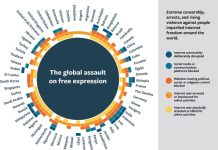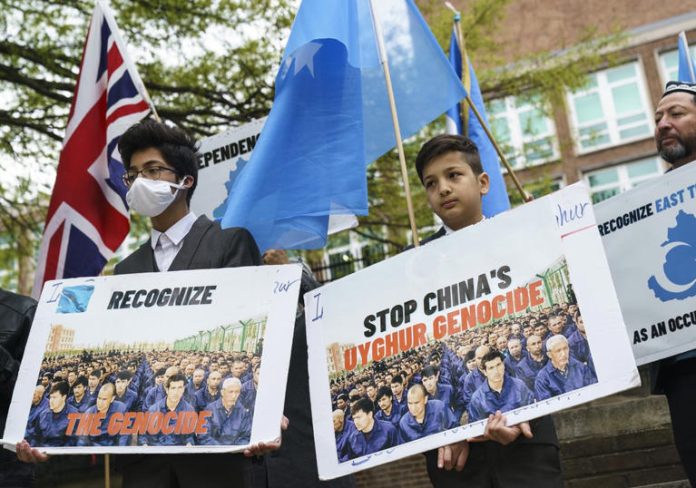China’s coercive labor transfer programs are the new detention camps, said Adrian Zenz, a leading academic on repressive policies on Muslim ethnic minorities in the Xinjiang Uyghur Autonomous Region.
Zenz’s latest update on Beijing’s so-called employment and “targeted poverty alleviation” schemes, to be published Thursday by the Jamestown Foundation, reveals an escalation in what he describes as a “non-internment state-imposed forced labor mobilization system,” one whose numbers in 2023 not only surpassed those from the previous year but also outstripped state-mandated quotas.
“Labor transfers are part of the new coercive strategy,” Zenz, a senior fellow in China studies at the Victims of Communism Memorial Foundation, told Sourcing Journal. “The internment camps were a targeted campaign planned to last for about five years in total. The forced poverty alleviation through employment-that is a long-term strategy, and I think that’s why we see that it is intensifying. It’s getting more comprehensive.”
The scope of the programs is also growing, he said. Whereas state-sponsored efforts to mobilize hundreds of thousands of Uyghurs into low-paying work placements previously took place, for the most part, within Xinjiang, authorities have “significantly” expanded the scale of the “pairing assistance” program to other provinces over the past year. The Xinjiang government itself openly declared last February a desire to increase the proportion of “poverty-alleviated laborers” to other provinces from 2.5 percent to more than 3.5 percent. Carried through, this would have resulted in the number of people transported from their home regions increasing by nearly 38 percent from 27,600 to 38,000.
That August, as documented by the official newspaper of the Central Committee of the Chinese Communist Party, Chinese leader Xi Jinping charged officials to “encourage and guide people from Xinjiang to find jobs in the mainland, and encourage and support people from the mainland to start businesses and live in Xinjiang.” The provinces of Anhui and Hubei received and continued to employ thousands of workers in 2023 alone, according to state media and documents.
“It’s quite significant because we’ve not had any evidence on those for about four years since early 2020; we’re seeing a lot of doubling down now,” Zenz said. He added that the move is particularly insidious because it results in what Chinese academics have dubbed the “demographic reengineering of Uyghur society-an ‘optimization’ of the ethnic population structure by removing Uyghurs out of the heartland and reducing the density of the Uyghur population.”
The findings bolster evidence gleaned from documents such as the Nankai report-leaked by Zenz in 2021-that indicate a broader campaign of cultural and religious genocide behind these euphemistically termed initiatives, though Beijing, for its part, has repeatedly and vehemently rejected the allegations as “slanderous attacks” from the West.
“And, of course, China just solves a basic problem of increasingly costly labor with rising wages and rising fringe benefits and costs in eastern China [with the] abundance of cheap Uyghur labor,” he said, noting that Uyghurs earn far less than their majority Han Chinese counterparts-and that’s before they have to pony up for costs such as food, housing and transportation. The exploitation, in other words, is a doubleheader, with motivations that are as much economic as they are political.
Zenz said that the implications for Western industries, including fashion, are now much greater because “this affects secondary industries that are processing stuff that may or may not be from Xinjiang. They may not otherwise have a supply relationship to the region.”
Of note in the report is Xinjiang’s increasing deployment of an “unemployment monitoring and early warning” mechanism, which Zenz first documented in 2022. The program involves the real-time tracking of incomes and employment statuses of millions of rural households. The program is increasingly becoming the “No. 1 reason” why China’s actions can be described as forced labor, he said. Previously, the leading reason was coercive recruitment and “all the mechanisms that happened at the grassroots level,” including land grabbing that leaves Uyghurs without homes to return to. Those still exist and in many cases accelerated, but there is now a “greater emphasis on retention, institutionalization and the sort of normalization of what has been achieved.”
“Uyghurs’ lives have been changed,” Zenz said. “And now you want to retain them through surveillance and monitoring.”
So what does this mean for brands and retailers? For one thing, they have to be more preemptive in their measures.
“You have to realize that firstly, this problem isn’t going away,” Zenz said. “Uyghur forced labor is not going anywhere. Second, it’s actually intensifying. It’s expanding in scale, transfers to other provinces are increasing, [and] so the risks arising [in Xinjiang] are present in other parts of China.”
Not to mention the fact that 90 percent of Chinese cotton hails from Xinjiang, a cause of much consternation for fashion firms seeking to comply with the Uyghur Forced Labor Prevention Act, which blocks products with any nexus to the province from entering the United States. More Uyghur-related legislation could be coming down the pike, too: On Wednesday, the House of Representatives passed a bill that would prohibit the State Department and Agency for International Development from funding the purchase of goods made in Xinjiang.
Despite its “strategic shift” from reeducation and internment of ethnic groups, Xinjiang still has what Zenz characterizes as a “greatly enlarged” detention and prison system, with waves of arbitrary detention continuing to take place. At the same time, labor transfers are a “less visible” form of repression and control while remaining a “very strong” form of assimilation. They also evade many existing conceptual frameworks of forced labor, including those used by the International Labour Organization. In short, companies’ exposure to exploitation in China will only climb.
“It’s a very significant exposure that may or may not mean that some brands have to even divest from China,” Zenz said. “Certainly, they have to invest a lot more in due diligence and take more precautionary steps not just to be presumably one step removed from Uyghur forced labor but try to be two or three steps removed.”
































